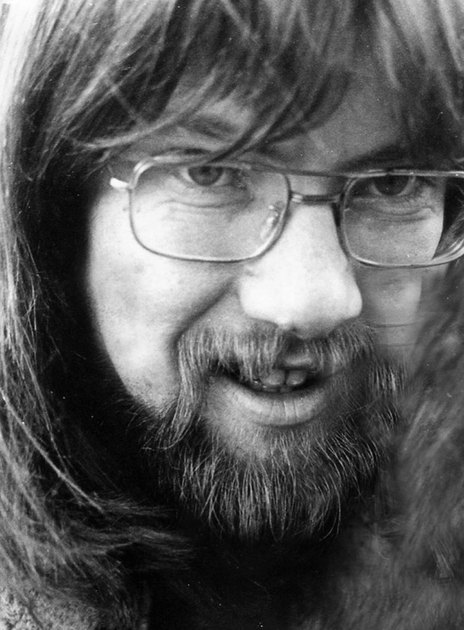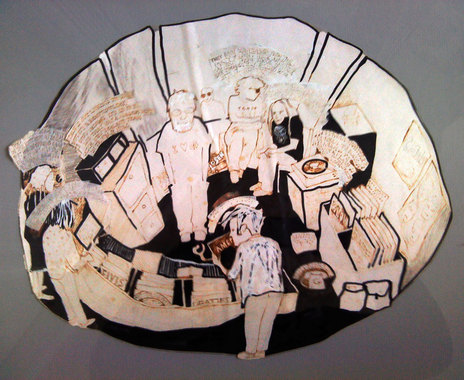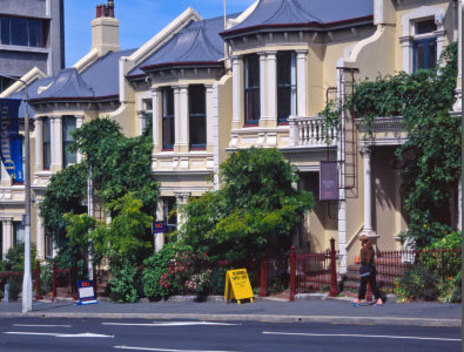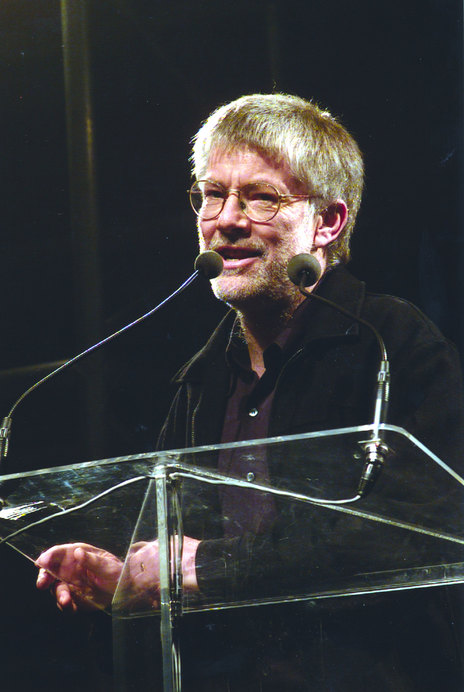AudioCulture
The noisy library of New Zealand music
Te pātaka korihi o ngā puoro o Aotearoa
Roy Colbert
aka Roi Colbert
Colbert was in the eye of the storm that was the Dunedin Sound, being a conduit between the artist and the audience through his legendary second hand record store, Records Records. This, coupled with his career covering local, national, and often overseas musicians has seen him gain the reputation as the Godfather of the Dunedin Sound, though he disagreed with this title.
Roy Colbert (also known as Roi Colbert) was born and bred in Dunedin lad, with a huge love of music, sport and his city. While an avid cricket and competition level table-tennis player (he played for Otago in the 60s), music was a huge factor in his life, though his first gig wasn’t The Beatles, or The Rolling Stones at the Dunedin Town Hall – it was Herman’s Hermits, a triple bill with Tom Jones and Ray Columbus and The Invaders. Colbert’s writing career began while he was at high school. He provided match statistics (and later text) for Evening Star sports writer Lankford Smith, and he developed a dual role at the newspaper, reporting on music with the column ‘Page 5 Pop’ in Friday’s paper. He continued on this path at Otago University, becoming the music and sport editor for Critic, the University’s Student Association magazine.
This led to a long period writing the music column for Dunedin newspaper the Evening Star. “I just went to the Star and said I’d organise it all if you want to have a music column,” he explained. “So I did that until The Star stopped in 1979. And from that came a whole lot of magazines.”
In the late 1960s, Colbert corresponded with Erika Von Kessler, a close friend of the Mamas and Papas, who answered their fan mail. This came from an article he was writing on the group, a band he said “nobody wrote about.” Von Kessler sent him information and news on the Laurel Canyon and LA music scenes, which Colbert, understandably, describes as magic. “She said she’d like to keep writing, so yeah, we did that for about five years. They lived in the middle of all the musicians in that Canyon, so that gave me an incredible amount of gossip and information.” This news from LA gave him an insider’s perspective on the scenes, and an edge on other writers, who were waiting for freighted copies of Rolling Stone and NME to arrive here months later.
In 1971 a new, initially temporary, venture began for Colbert: a record shop. “My girlfriend and I were looking for somewhere to live, and we wanted to live right in the middle of town,” he says. They moved into the upstairs apartment in the Stuart Street terraced houses, which had a spare room that they used as a shop. “We thought ‘what can we sell’, and I had like two million records. It was kind of a hippie shop – we had beads, rolling papers, we had posters all ‘round the walls. It grew into something much bigger, but it was again – like writing, pretty accidental. We thought, maybe six months, give it a try.” The shop in question, (originally called Roy’s by his customers, before being briefly coined Astral Weeks) grew into Records Records, a haven for lovers of music old and new, and a great place to go to find obscure or forgotten titles.
Records Records was the Dunedin distributor for Flying Nun material, and on any given day in the store you could find yourself in the company of local musicians, from the up-and-coming, to the likes of Martin Phillipps or Graeme Downes. Colbert continued Records Records until 2005 when ill health (which led to a kidney transplant) meant he sold the business. Sadly, the shop closed permanently in 2010.
Colbert was central to the Dunedin Sound, selling material by the artists involved, as well as championing them in the press.
Colbert was central to the Dunedin Sound, selling material by the artists involved, as well as championing them in the press. The period around the recording known as the Dunedin Double (real title The Verlaines, The Stones, The Chills, The Sneaky Feelings, Flying Nun, 1982) was a fertile time for local musicians and Colbert knew them all, as they frequently visited his store, and his house, watching early 80s rock videos. Colbert modestly downplayed his, and Records Records’, significance during this time, saying, “I think the shop was probably important, but that doesn’t reflect on me ... I just sat there in a chair. I got far more recognition than I deserved for that.” Colbert’s knowledge of Dunedin music was showcased in his liner notes for the comprehensive retrospective of Dunedin music and musicians, But I Can Write Songs OK: 40 Years of Dunedin Music (Yellow Eye, 1996).
However, it was the musicians involved with the Dunedin Sound who he was most closely associated. His early championing of their music in the Listener and Rip It Up was followed later in his liner notes to The Chills Kaleidoscope World (Flying Nun, 1994), DoubleHappy’s Nerves (Flying Nun, 1992), and the Tuatara compilation (Flying Nun, 1996).
Colbert’s involvement with the Dunedin Sound also led to him discussing with Graeme Downes the idea of the songs being staged to focus on them, and the quality of songwriting in the scene. This was the genesis of the 2015 Tally Ho concert, in which the songs of the Dunedin Sound were re-imagined, and performed by opera star Anna Leese and the (former) Southern Sinfonia, plus rising local vocalists, and some of the original artists.
Colbert’s writing for various publications, including The Listener, The Sunday Star Times, and golfing magazine The Cut, continued throughout his career as shop-owner, and he met some infamous musicians and artists during this time. “I could quite often have an afternoon with them, I’d drive round … with them – it was amazing. So I met heaps of people that way.” Among the many well-known local and international names, there are some stories that stand out, like David Bowie being unable to work a toaster. Colbert has some fascinating tales to tell, including the one about how he attended Led Zeppelin’s apres-gig party in Auckland, wearing purple flares. (As he arrived at the bottom of the stairs he was greeted by the sight of Robert Plant, standing like a Nordic god at the top, a light streaming through his curly mane, and a blonde under each arm.) He wrote about the Led Zeppelin encounter for Rolling Stone, when the band had boycotted the magazine after a bad review.
Another tale he vividly recalls is Lou Reed’s 1975 press conference at Wain’s Hotel in Dunedin. Reed insulted everyone present (including Colbert), leading to a mass walk-out of journalists, with only Colbert and Jim Mora staying until the end. Colbert remembers Reed as “a prick, but he’s fascinating,” adding “he had a big bible, a pharmacology Bible, he’s just obsessed with drugs ... it was kind of fascinating!” Then there was the time he interviewed Steve Nicks around 1980, recalling she talked about goblins and witches at the bottom of the garden. Or so he remembered.
Colbert credited two things for these opportunities. “I was lucky being in Dunedin,” he says. “No-one else kind of wanted to meet them, or maybe one other person. Occasionally I’d have to go to Auckland … I’d be in a press conference with a semi-circle of people from radio stations. I was just one little voice in that room. I also got to help the promoters. You help the promoters; you’re giving them free ads, so they all considered me a friend.”
His local interviewees were diverse too. Among those he advocated for were Phil Judd, Lea Maalfrid, Wing, and Demarnia Lloyd. His last major interview was a piece for North & South magazine on folk favourite Nadia Reid.
After selling Records Records in 2005, Colbert was quietly busy, his wit and knowledge extending to his weekly Otago Daily Times column, ‘Dazed and Confused’, where his tales combined humourous anecdotes, personal reflection, and serious observation, often drawing on his own life and adored family (and health issues) as subject matter. A discussion with him on the topic of the Dunedin Sound was always entertaining, and brutally honest, and his insights into the local music scene in the 1980s were invaluable to Ian Chapman’s 2016 book The Dunedin Sound: Some Disenchanted Evening.
While he thought there was enough infrastructure around the local Dunedin music scene (the University’s rock course, Albany Street Studios, Dunedinmusic.com, etc), he also considered “you’re never ever going to get Shayne Carter, Martin Phillipps, Peter Gutteridge, Graeme Downes, Robert Scott, David Kilgour… all those people at the same time ... That wasn’t created by some brilliant thinking on someone’s part, or great venues or whatever, it’s just an accident.”
Roy Colbert passed away on 20 July 2017, after a period of ill health. He was the always the best (and most humorous) person to talk to about the “golden age” of Dunedin music, and the tightly-knit musical bonds around it, offering insightful comments, or dispensing ready quips. He remained humble in his estimation of the shop’s influence on the local scene, which he championed heavily.
“In retrospect, now when you’re talking to [the musicians] and they’re 40 or 50, and they talk about coming in in their short pants at school, it was a big deal to talk to me. I don’t think it’s a significant thing really, but second-hand shops influenced the music a lot ... I was a jingle-jangle Byrds, Beatle-Byrds pop-rock-folk sort of guy, and that’s kind of what the Dunedin Sound bands were, they were all jingle-jangle guitar bands.”
Colbert’s place in Dunedin music folklore (and history) is undoubted; in 2015 he was voted one of the city’s most influential citizens in its 170-year history. He will be remembered fondly as an extremely witty, kind man with an encyclopedic brain, a love of lollies – and the best record store.
---
Roi Colbert passed away on 20 July 2017. His last story for AudioCulture, Low Fidelity, is about Dunedin record stores of his youth. Samples of his writing for Rip It Up are republished here.




Visit our sister site
NZ On ScreenMade with funding from
NZ On Air